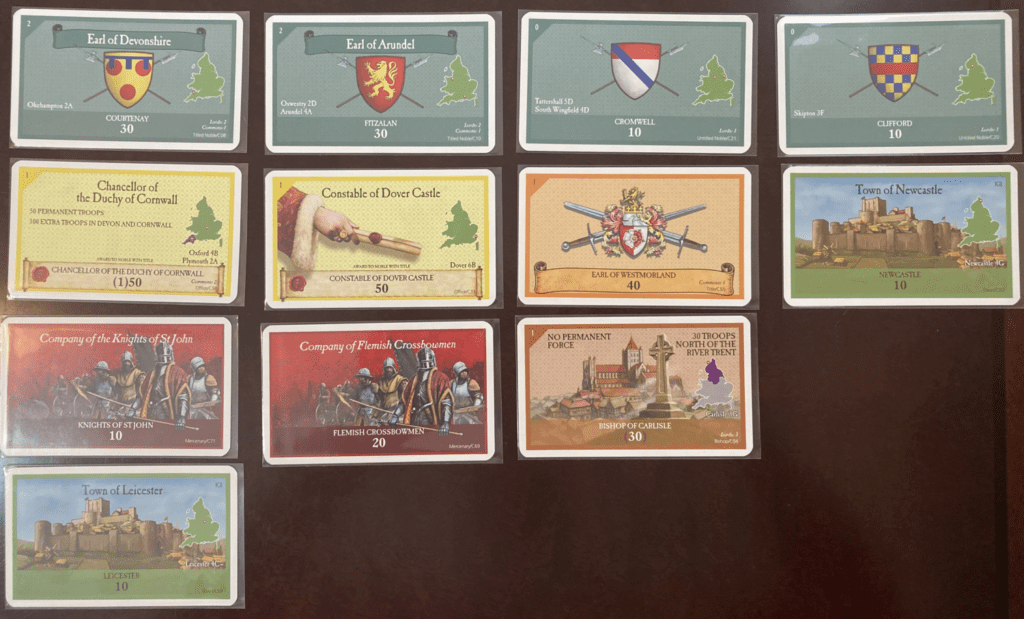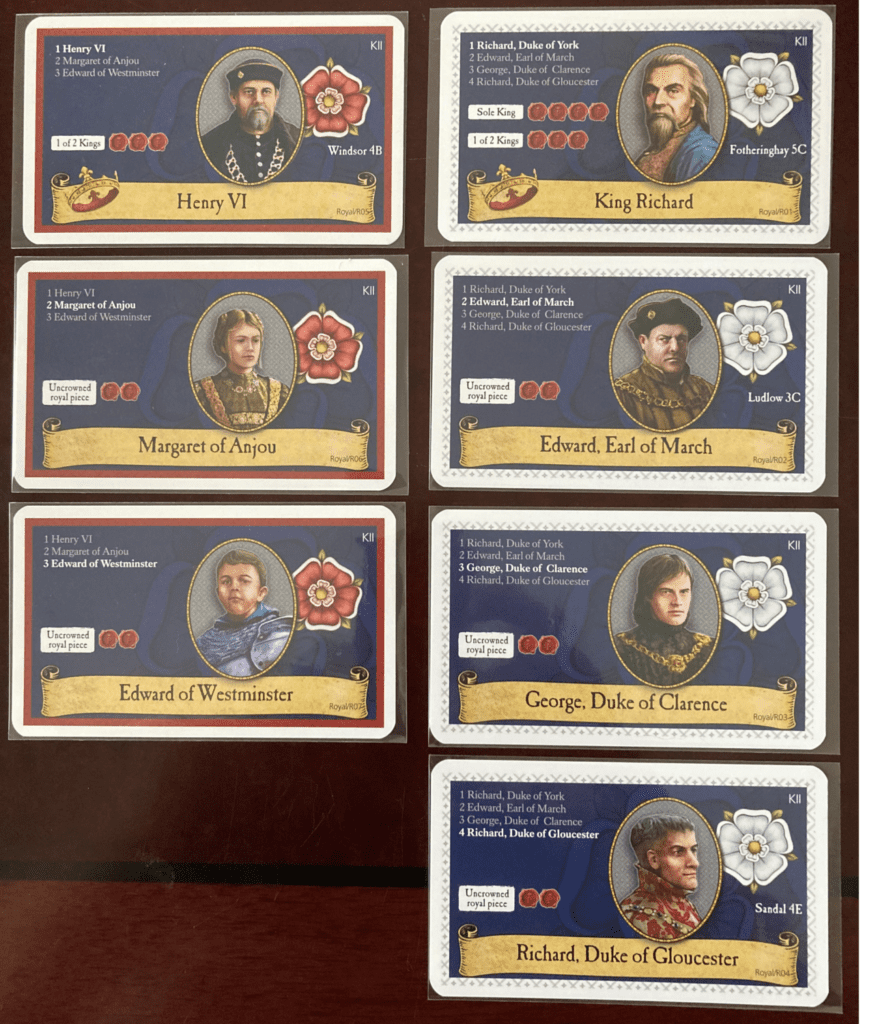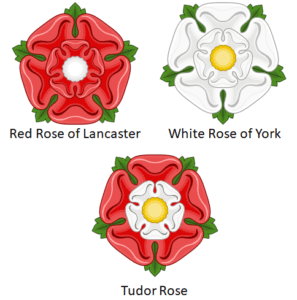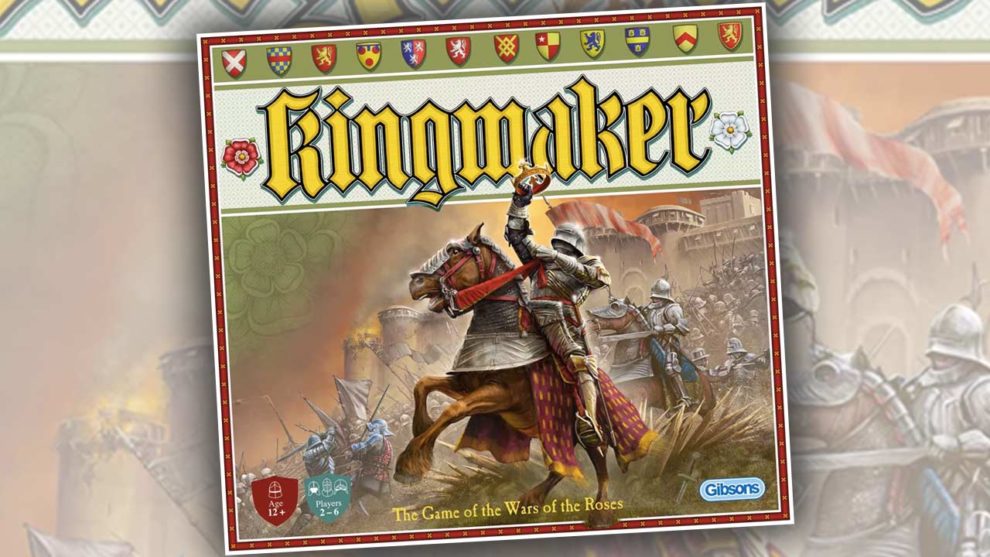What is Kingmaker?
Kingmaker is a game covering the War of the Roses, the dynastic clash for the throne of England between the houses of York and Lancaster from 1455 to 1487. A remake of the 1974 Avalon Hill classic of the same name, this latest version by publisher Gibsons has a double-sided board and two rulebooks, one for playing Classic Kingmaker, and the other for playing Kingmaker II —a streamlined version of the game. Depending on the version, the game can support up to 5 or 6 players. There is even a solo mode. This review is limited to Kingmaker II.

Each player controls a varying number of nobles at the start of the game, along with the troops loyal to those nobles. Nobles can be awarded titles, offices within the English royal court, bishoprics, control of towns and cities, mercenaries, and ships. These are used to fight battles, conduct sieges, and gain control of royal family members from the House of York or Lancaster. An immediate Royalty victory is won when one player controls the only royal family member who has been crowned king. Barring that, a faction controlling a king can win a Prestige Victory under certain conditions.
Game Board
The game board depicts a map of mainland England and Wales, as well as the Isles of Wight, Man, and Anglesey, and the fortified town of Calais on the French coast. The map is divided into regions delineated with purple borders, each of which is composed of areas delineated with white borders. Areas contain the castles of noble families (indicated with heraldic shields), cities, fortified and unfortified towns, ports, and Royal castles. A road network is superimposed on the map which can greatly increase the mobility of the playing pieces.
Fortified towns, cities, and castles have intrinsic garrisons. These garrisons add their strength to any faction owning and occupying the location. Each location can also house troops in addition to their garrison. If the total number of troops exceeds the limit for the location, some of the nobles and their troops will need to be placed in the fields outside the location.

The game board also contains spaces for holding the various types of cards used in the game, tracks for indicating army troop strengths and faction prestige points, and for indicating alliances between the different players/factions.
Assigning Crown Cards
At the beginning of the game, each player is dealt an equal number of crown cards depending on the player count. Each noble can hold only a single title and office. Therefore, players must assign any title crown cards to nobles that don’t already have a title. They can then assign one, and only one, office to each noble with a title. Beyond that, they can assign any number of bishops, towns, mercenaries, and ships to their nobles.

Each crown card lists one or more locations on the map. Players place a control marker of their faction’s color on each of those locations. Each noble is then placed in one of the locations listed on their crown card. That noble’s troop strength is the sum of all the troops indicated on their crown card and the other cards assigned to them.
Crown cards not only provide troops, but also prestige points and other benefits, as we’ll see. Nobles of the same faction can freely move crown cards amongst themselves if they occupy the same location. Crown cards can also be gained or lost during the game due to certain events, including sieges and battles, and the summoning of Parliament.
Sequence of Play
Each player in turn order executes the following 6 phases on their turn:
- Event Phase: Draw an event card and apply its effect.
- Movement Phase: Move any or all nobles and ships.
- Combat Phase: Resolve battles and sieges.
- Parliament Phase: Under certain conditions, summon Parliament.
- Coronation Phase: Under certain conditions, crown a royal family member under your control.
- End of Turn Phase: Draw 2 Crown cards and then discard 1 Crown card.
Events
The event cards are dual use. The upper left-hand side of the card is used in the event phase, and the lower right-hand side during combat. Events include plagues, raids, revolts, storms at sea, and other random occurrences. These events may result in the death of nobles or may force them to move to another area of the board. The event deck also contains cards that can be used to summon Parliament during the Parliament phase.

Movement
Players can move their nobles overland in one of three ways. They can move from one area in a region to another area in the same region. They can move from one area in a region to another area in an adjacent region. Finally, they can move from one area containing a road to any other area connected by road. However, if the road crosses an enemy controlled fortified location, the moving player must cease movement unless that location’s owner permits them to pass. Regardless, when a noble ends their movement, they must indicate whether they are occupying a controlled fortified location present in the area or occupying the field outside the location.
Players can also use ships they control to move via sea areas. To do so, the nobles must embark at a friendly or unfortified port containing one or more of their ships. The number of troops that board must not exceed the capacity printed on the ships(s). Each ship can move up to 5 sea areas and can stay at sea to disembark at a friendly or unfortified port on a later turn. However, beware of a Storms at Sea event card as it will force ships to land at the nearest port, even if it is unfriendly.
Combat
After a player completes movement, they can conduct attacks in areas occupied by their opponents. Attacking isn’t mandatory. If the opponent occupies a fortified location, the active player can lay siege to it provided their troop strength is equal to or greater than the occupants. An event card is played and if the lower right-hand side of the card is anything other than a Bad Weather Delays Attack, the siege was successful. If the siege is not successful, the player can attempt to try again on their next turn.
For field battles, each side compares their troop strength and determines the odds ratio. An event card is then drawn. If the combat odds in the lower right-hand side of the card fall within the range of odds shown for a victory, then the player with the larger troop strength wins. All named nobles on the event card present at the battle are killed, although each player can only lose a maximum of one noble. In that case, the noble with the largest troop strength is killed.
In either sieges or battles, starting with the defender and going clockwise, players can add crown cards from their hand to their nobles in the battle. This continues until all players pass. So, while you might begin a battle with numerical superiority, your opponent can turn the tables on you. The attacker can never win a battle if their troop strength is equal to or less than the defender’s. However, they can inflict casualties on enemy nobles if they get lucky and draw the right event card.
Nobles killed, whether by a plague or battle, are removed from the map and any titles or offices they possess are put faceup in the Chancery. where they can be assigned to other nobles during the next meeting of Parliament. All other crown cards are simply discarded. Nobles on the losing side who are not killed in battle are captured. The winner can either execute them, in which case their titles and offices are put in the Chancery, or ransom them back to the losing player for some consideration (e.g., transferring or trading crown cards). The winner also seizes any Royal family members present on the losing side. As compensation, the losing player gets to draw half as many crown cards as they lost.
Parliament
When a Clamour for Parliament event card is drawn, the player controlling the sole King may summon Parliament. Alternatively, Parliament can be summoned by the Chancellor of England if there are no kings or two kings and they play the Chancellor May Summon Parliament card. In either case, the sole King or Chancellor of England must occupy an Area containing an unfortified town or friendly fortified town or city, but not a castle. The player summoning Parliament then names a Noble from an opposing faction. That noble immediately relocates to the area where Parliament is meeting, except if they are besieged, at sea, or outside mainland England and Wales.
All players in clockwise order, starting with the player who summoned Parliament, may then have any of their nobles voluntarily attend Parliament provided they are able to do so per the restrictions above. Once this is done, the player summoning Parliament shuffles all the cards in the Chancery and draws a number equal to the number of nobles attending Parliament and reveals them. The King or Chancellor awards the revealed crown cards to the nobles in attendance per the rules (each noble can possess only one title and office, nobles can’t hold an office unless they have a title, etc.). Crown cards that can’t be assigned are discarded.
The King’s Peace marker is placed in the area Parliament met. It prevents players from attacking each other for one complete round. When the summoning player’s next turn ends, the Clamour for Parliament card is discarded, and the King’s Peace marker is removed. There are four Clamour for Parliament cards in the event deck, so Parliament can be summoned at most four times.
Coronation

There are 3 royal family members in the House of Lancaster. The line of succession is (1) King Henry VI, (2) his wife, Margaret of Anjou, and (3) their son, Edward of Westminster, in that order. At the start of the game, Henry VI is the sole King. If he should die, then Margaret can be crowned queen regent. If she also dies, then and only then can Edward of Westminster be crowned King.
There are 4 royal family members in the House of York. The York line of succession is (1) Richard, Duke of York, and his three sons, (2) Edward, Earl of March, (3) George, Duke of Clarence, and finally (4) Richard, Duke of Gloucester. The most senior living member of the House of York can be crowned king, even if there is a Lancastrian king in play. Thus, there can only ever be two kings in play at the same time, one Lancastrian and one Yorkist.
A noble possessing the senior surviving member of the House of York or House of Lancaster can crown them King provided the noble and Royal family member occupies an area with a cathedral and possesses either one Archbishop or two Bishop cards. The Royal member piece and Royal card are flipped, and the faction’s prestige is increased accordingly.
Components
Gibsons did a great job producing the remake of this classic. The artwork by Mat Edwards is evocative of the period, especially with the use of the heraldic shields of all the noble families. The event and crown cards which drive most of the game play are easy to read. The inclusion of the mini maps on the crown cards indicating the whereabouts of the named locations makes set-up a breeze, especially if you’re not familiar with the geography of England and Wales.
Both rulebooks are logically laid out, sufficiently illustrated, and well written. Once the rules, which may seem complex at first, are mastered, players can simply consult the player aid to answer most of their questions. The dual-sided board is colorful, yet easy on the eye and to interpret. Another plus with this version is each faction has playing pieces for every noble in the game in a unique background color, a big improvement over the original Kingmaker.
Thoughts on Game Play
Players are not allowed to attack each other on the first turn. Instead, they scramble to maneuver their nobles to capture locations containing a royal member of the House of York or House of Lancaster. This usually will entail combining the armies of two nobles since players need to have a troop strength at least equal to a location’s intrinsic garrison. The cities of London and York each have a garrison strength of 300, making it unlikely anyone will try to capture Henry VI or the Duke of York. Therefore, the likely targets will be Margaret of Anjou, Edward of Westminster, and the Duke of York’s 3 sons.
Assuming a faction is successful in besieging a location and capturing a royal, they will then need to protect their prize, while at the same time trying to capture or kill rival royals and those higher in the line of succession. Control of fortified towns and castles astride roads will impede the movement of other factions. But these locations will need to be garrisoned with sufficient troops to withstand a siege.
Winning a major siege or battle – one that involves at least noble on each side – awards the victor a Major Siege or Battle crown card that is worth 1 or 2 prestige points, respectively. Winning also causes the losing side to discard crown cards, and thus lose prestige points, if the winner decides to execute them. Or they can be ransomed for crown cards. In either case, this can tip the scales in your faction’s favor. However, you can’t coronate a king unless you have an archbishop or two bishops, as well as control a location with a cathedral. And without a king, you cannot win the game.
Titles and offices lost as a result of a siege or battle wind up in the Chancery where they can be reassigned during the next summoning of Parliament. Therefore, the faction having the sole king or Chancellor of England has a huge advantage in that they decide how these crown cards are assigned. Furthermore, two or more factions can form an alliance. Thus, you can ensure you and your allies gain these spoils, increasing your chances of winning a prestige victory. But beware of backstabbing! Players can choose to leave an alliance during the End of Turn phase, taking those spoils with them.
As you can see, Kingmaker is not simply a wargame. It is as much a game of political maneuvering as it is one of battles. Your faction’s power and prestige will ebb and flow, as much as by random events as by the results of combat. Players who can deftly negotiate both aspects, and overcome setbacks, are more likely to come out on top. This is what makes this game so challenging, yet rewarding if you succeed.
Summary

So, does Kingmaker accurately portray the War of the Roses? From all I’ve read, I’d say yes. It’s not a case of if there will be twists and turns, but a near certainty there will be. Indeed, I’m certain no one at the time would have predicted that the male lines of both the House of York and Lancaster would be eliminated, thus opening the door for the House of Tudor to inherit the royal claims of the House of Lancaster. By marrying Elizabeth of York in 1486, Henry Tudor united the houses of York and Lancaster, putting an end to the War of the Roses. Henry VII, now King of England and Lord of Ireland, symbolized this by combining the Red Rose of Lancaster with the White Rose of York to create the Tudor Rose. The House of Tudor would rule England until Queen Elizabeth I’s death in 1603. It’s no wonder this conflict was the chief inspiration for George R.R. Martin’s A Game of Thrones.
Is Kingmaker for everybody? Probably not. For aficionados of this historic period, it will be a must buy given there are relatively few games about this conflict. Anyone seeking a multiplayer game of war and politics might also find this game appealing, provided they are not dissuaded by the 6-hour playing time. I also imagine that some might be put off by the game’s randomness, between the events and non-deterministic combat system. All battles, regardless of the odds ratio, can result in adverse consequences.
As for me, I found Kingmaker challenging yet enjoyable. Replay value is enhanced if players decide to create their own factions instead of using the preset factions provided with the game. The preset factions are balanced, so creating your own faction based on a random deal of crown cards could be challenging early in the game. But that just makes victory that much sweeter.












I have been a fan of Kingmaker ever since a friend introduced the game to me back in 1987. Back then with a few navy buddies, we played a *lot* of this game. The issues with the game and its original production runs are quite familiar. When I saw that a new edition was being produced, I was hesitant. This is not a game I am going to get the vast majority of my gaming group excited about.
But after reading your review, I do think I can get enough of my gaming group to the table to make this game worth purchasing and a viable addition to my game collection!
Thanks for a wonderful review.
You are certainly welcome. Have you ever tried Crown of Roses? It gets a bad rap, but I quite like it.